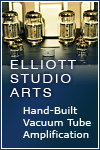The folks at Reference Media encouraged me to create a new series of lower priced, easier to assemble products that they can sell at their stores. This prompted me to re-consider my stance on printed circuit boards (PCB's). I still believe that they are not good for tube circuits because of the high-voltage and heat involved, and the capacitive properties of the board itself, but if designed and implemented with care they can work just fine. After all, most of the other tube manufacturers out there use PCB's. The new series will use PCB's for ease of construction, have simpler casework with silk screened front panels (instead of engraved) and integrated power supplies (instead of external).
The Sixty-Six Series (66-100 power amp, 66-001 preamp and derivatives) represent the premium products that we produce and will remain unchanged; full point to point wiring, external power supplies for the preamplifiers, engraved front panels, more robust and complex casework. I still believe that point to point is superior for tube circuits and sounds more transparent, and allows for optimum circuit component layout since it's three-dimensional. The lower priced series (yet to be named) will retain the same parts quality and circuit design but at lower price points for reasons stated above.
So, the first foray into this new paradigm is a headphone amp. The circuit is a virtual copy of the 66-001 line stage, minus input selector, balance, mute and mono controls. The original 66-001 preamp started out as a headphone amplifier that I breadboarded up several years ago and found to be an outstanding preamp. So it was a no-brainer to make a headphone amp out of this circuit.
The amplifier and power regulator circuits will live on the same PCB. This same circuit board can be adapted to a full blown linestage with some changes in casework and the addition of the requisite switches, pots and jacks. This allows flexibility and further reduces costs. It has stereo unbalanced inputs and parafeed transformer coupled outputs. There is a low/high gain switch that switches primary windings on the output transformer to accommodate differing impedances and sensitivities and should drive most any headphone out there. Each amplifier stage has multiple bypasses on the power rails, which is regulated, along with the filament supply.
Many hours were spent up front designing the circuit board, drafting the casework and specifying parts that will fit. This process resulted in me finding better parts that will be carried back over to the Series Sixty-Six products.
As with all PCB's I've designed, there were things that didn't quite fit, and a few mistakes. That's the way it goes; you never know until you get that first one and start loading parts. It's a process, but now all the corrections are made and the prototype is built. Not without a few mishaps! I had to replace the high-voltage regulator mosfet (4 different times!), because of shorting it out while measuring the rail voltage. The meter probe kept slipping off a resistor leg. Bang! One thing about PCB's- the parts are hard to remove once they're soldered in place.
In the photo you can see the two output transformers in front, the PCB mounted volume control and the large poly coupling caps. Further back are the tubes and related amplifier circuitry and at the rear of the board is the PSU regulator circuits. Outside the picture are the two power transformers. Of course this will all fit into a box about 12" wide by 10" deep and about 4" tall. The tubes will stick out the top of the box, which will have plenty of vent holes.
Playing back high-res flac files from my computer's external soundcard and driving my Grado SR80 'phones, the sound is wonderful, in fact, it sounds just like the reference 66-001 preamp upstairs in the living room..
Stay tuned for progress on this new product development. Next comes the casework and the revised PCB.
Fostex FE206En Rear-Loaded Horn Speakers
10 years ago








